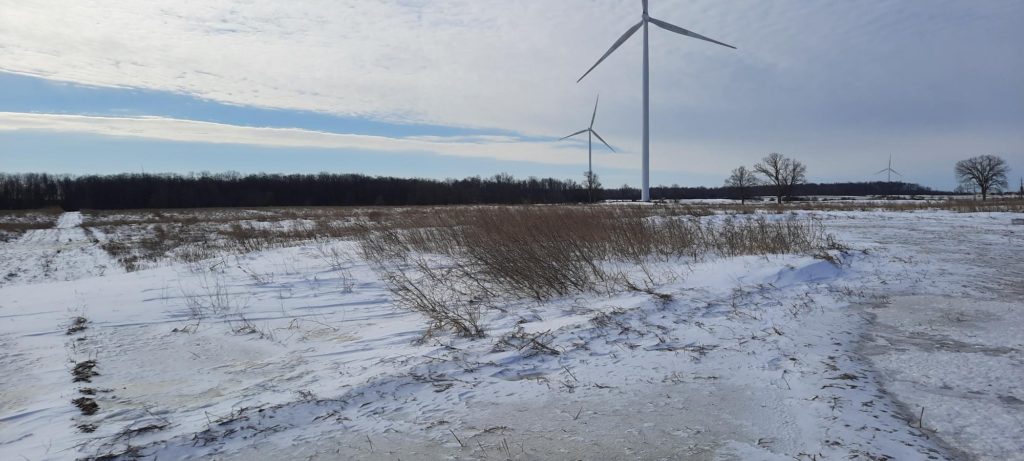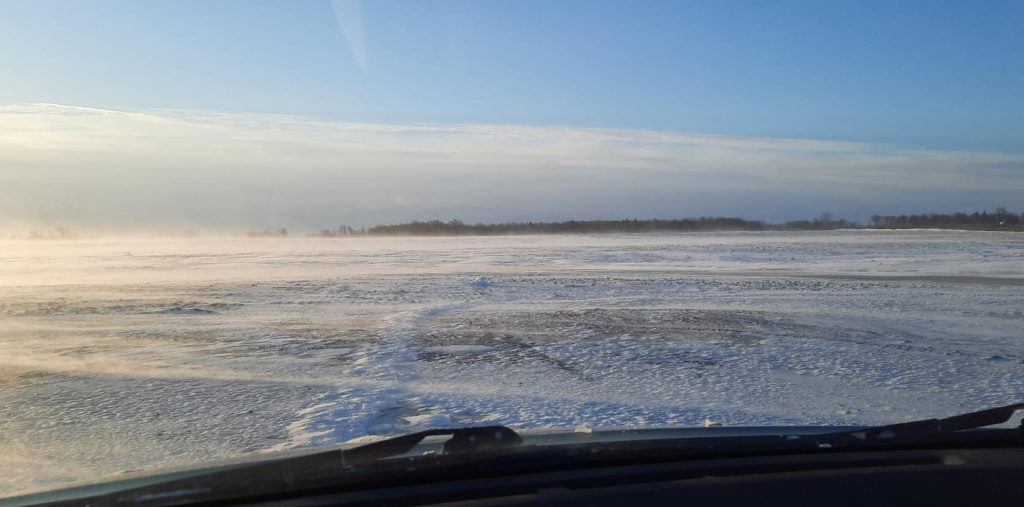February is having a hard time deciding whether to hold onto Winter or move into Spring. For a period of a little more than 3 weeks it was definitely Winter with cold and snow to prove it….and Snow Buntings. But a recent warm snap and rain, which ate up all the snow, is pushing us toward Spring and pushing the Snow Buntings out. We were having a pretty productive Snow Bunting banding season spread over 3 Haldimand sites: at my site near the York Airport on Stoney Creek Road; Nancy’s site on Dry Lake Road and Duxbury Road on 9th Line near Clanbrassil; and Marnie’s site on a farm on Irish Line, east of Cayuga. And we’ve done reasonably well: I’m just over 800 banded; Nancy pushing 300; and Marnie just over 600. Not only have we banded a good number but we have retrapped quite a few – some from banders further away and some that have roamed locally from one of our sites to another. In fact one bird that was banded at the airport was retrapped a couple of days later – on the same day – by both Nancy and Marnie….so these birds move around when they’re foraging.
But the most interesting thing for me has been the comparison of the sites. Both Nancy and I are banding on agricultural fields that were cropped during the Fall. Once the soybeans/corn was taken off they were just empty, devoid of plant life – especially the soybean fields. Marnie’s site however was on the edge of a large fallow pasture field that had been let go for the year and was covered with numerous dried week stalks, replete with seed heads. And herein lay a great difference. I banded 350 Snow Buntings over 8 days in January (43.75/day) and another 463 in February over 12 days (38.6/day). Marnie got a late start banding only 6 birds in one day at the end of January (despite all my urgings she continues to work during this critical Snow Bunting period!?). But in February, over just 5 days, she and her helpers banded 607 birds for a daily catch of 121! (Her 6-day total is 102/day.)
The reason for the difference is the vegetation covering the two “types” of fields. Modern agricultural practices, with the heavy use of herbicides (and pesticides) is clearing huge swaths of land of any potential food for ground-feeding (seed-eating) birds. To catch birds at my site I essentially have got to set up a “feeder” system: I put out cut corn early in the season, hope for Horned Larks to find it, and keep replenishing the bait daily (usually twice daily) so birds become not only aware of this highly nutritious food source but come to depend on it – like birds in your backyard depend on your feeders in the Winter. Once that happens then you can pretty confidently expect birds to use the site, especially during bouts of inclement weather.

The dried weed stalks sticking out of the snow provided a great deal of food (and cover) for Snow Buntings and American Tree Sparrows. -DOL
But the Irish Line site was altogether different. The birds found this huge food source…and then Marnie found them. It didn’t take them long to then find the cut corn bait piles that she was tantalizing them with at the edge of the field. But they weren’t dependent on them. The field was filled with “natural” food. This became very apparent to us the other day when it was bitterly cold with winds gusting to over 60 km/hour. The birds would fly into the trap area, grab a bite to eat, and then fly out into the field. Sometimes they were close enough for us to observe that they were finding lots to eat in the field among the weed stalks as the wind was shaking the dried plants, dislodging the seeds which were blowing over the snow cover. They scampered around pecking at a prodigious rate. Then they would fly back for some corn – a good balanced diet it appeared.
But the most remarkable thing when considering the two sites was the number of birds present. Nancy and I were happy when the birds around the sites ranged between 50-100. Occasionally this might get as high as 150 but more often it was down around 30 (and too often none). But at the farm site we were seeing flocks of 500 to a 1000 birds, sometimes pushing 1500. It was like watching a snow flurries descend over the field. No wonder a group of Snow Buntings is referred to as a “drift”. And it wasn’t just Snow Buntings that were taking advantage of this bonanza. At the back edge of the field, bordering a small woodlot, there was a group of American Tree Sparrows that we conservatively estimated at 500 individuals – I have never seen this species in this number and all feeding voraciously among the dried weed stems. [If a group of Snow Buntings is a “drift”, what is a group of Tree Sparrows? A “Log jam”?]
Once upon a time, before the advent of “industrial farming”, fallow fields were much more common and even tilled fields had emergent weed stalks. Now cropped fields are essentially deserts as far as ground feeding birds are concerned. To me it’s small wonder that Snow Bunting numbers have declined by 64% in the last 60 years.
Rick



Great article but also depressing. I wish our agricultural practices were more eco-friendly.
Great points Rick . In north eastern Ontario we seem to have a mosaic of totally cleared fields and many left with some kind of seed head on stalks of vegetation. We also have a site at each type so it will be interesting to tally the numbers at season end . We are looking forward to march when many of the “southern” birds find their way to the hilliardton marsh area . Hopefully we will catch another one of the birds you have banded . I really like the term” log jam of american tree sparrows” i looked it up and could not find any reference so i think it is yours. Better than a”clear cut” but i guess that is what created the fields that allow the “drifts” of buntings to thrive. The added stress of lack of natural food on top of inconsistent snow cover must be part of the decline. What percentage of your birds are female? In the north we have 5 percent female. So if the majority of birds in the south are female this may put the future of snow buntings more at risk I would imagine Thanks for the blog .
Hi Bruce. Yes…”log jam” is mine…Down here the ratio of females to males is a little better than 3:1. I think, historically, females have always wintered farther south. The males prefer to stay closer to their nesting sites so that they can arrive early and claim a territory. Males are larger and, so, can withstand more rigorous winter conditions. I think that in the long run the problem will be their ability to deal with increasing temperatures. They aren’t as well equipped to deal with them as birds in more temperate climates.